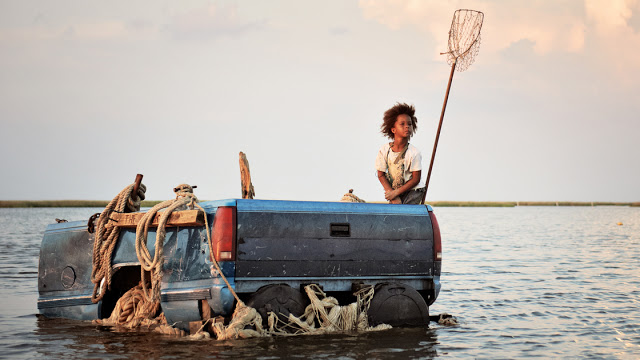 |
| Quvenzhane Wallis as Hushpuppy in Beasts of the Southern Wild |
Guest post written by Laura A. Shamas, Ph.D.
Later, the water serves as a source for spiritual cleansing; Hushpuppy embarks on a search for her mother, and finds maternal nurturing from women who work aboard a pleasure ship, the “Elysian Fields Floating Catfish Shack” featuring “Girls Girls Girls.” Wink’s passing, with final ship burial rites that are similar to those of the ancient Vikings, is connected to a spiritual return to the sea.
The theme of “regeneration” is clear in the ending of Beasts of the Southern Wild, and discussed in further detail below. Much more than a mere setting, water is part of every major plot turn, and somehow young Hushpuppy must learn to live with it, on it, and sail through it.
 |
| Beasts of the Southern Wild |
Classic tales from traditions worldwide feature flood motifs. The Sumerian Epic of Atrahasis predates Noah’s story; ARAS’ The Book of Symbols says the Atrahasis tale “describes casualties of flood strewn about the river like dragonflies.” [vi]
The familiar story of Noah’s Ark is one of many legends in which the deluge brings a renewal, the start of a new cycle, even a rainbow. In the Gilgamesh Flood Myth (which some scholars trace to The Epic of Atrahasis), Upnatishtim must build a boat to weather a storm so foul its verocity frightens the very gods who created it. Like Noah, Upnatishtim’s boat eventually lands atop a mountain.
In the Irish legend of Fintan mac Bóchra, Fintan escorted one of Noah’s granddaughters to Ireland. As one of three who lived through the deluge, Fintan “the Wise” survived the deluge by shape-shifting into a salmon and two birds; eventually he became a human again and advised the ancient Kings of Ireland. A Kikuyu story (Kenya) tells of spirits drowning a town with beer, as inhabitants find refuge in a tavern.
In China, the tales of “Yu The Great” center on flood fighting, with family sacrifices as part of the battles, and supernatural assistance in the form of a yellow dragon, or in some versions, Yu is the dragon. [vii] An ark features prominently in the Greek myth of Deucalion and Pyrrha, Prometheus’ son and Pandora’s daughter, who survive a flood unleashed by Zeus. Floods are also featured in numerous Native American tales, such as the Arapaho story of Creation, in which a man with a Flat Pipe enlists Turtle to help save the land or the Chickasaw Nation’s Legend of the Flood in which a raven delivers part of an ear of corn to a lone remaining family on a raft, post-Deluge.
 |
| Hushpuppy faces an Auroch in Beasts of the Southern Wild |
In Beasts of the Southern Wild, the melting ice cap imagery is linked to the global warming rise of coastal waters — perhaps Earth’s way of punishing humankind (which could be seen as divine chastisement related to myths above). The “watery end of the world” theme, the motorboat as ark, the tavern as place of refuge, the release of supernatural beings (such as Hushpuppy’s vision of the frozen Aurochs unleashed through global warming), the connection to animals and earth as agents of healing (Hushpuppy listens to them): all of these elements in the film may be seen as related to flood myth tropes. Although there is no rainbow at the end, there is definitely as sense of renewal as Hushpuppy becomes the new Bathtub leader. The imagery and mythic tropes in the film overall resonate with symbols of giving birth: from the womb-like ark, to overwhelming water which could be seen as related to amniotic fluid, through Hushpuppy’s search for her long-absent mother.
With our collective experience of Hurricane Katrina in 2005 and now Sandy in 2012, the poignant depiction of flood mythology tropes resonate strongly in this award-winning film. Watching Beasts of the Southern Wild allows us to consider the Deluge’s symbolic import to the human psyche not only as an image of destruction, but as an important signal of change, marking a time of transformation.
- [i] Jung,C.G. Symbols of Transformation. Collected Works, Volume V. Edited and Translated by Gerhard Adler and R.F.C. Hull. Princeton University Press, 1977. Page 211, Paragraph 311.
- [ii] Chevalier, Jean, and Alain Gheerbrant. Trans. John. Buchanan-Brown. A Dictionary of Symbols. Cambridge, MA: Blackwell, 1994. Page 1081.
- [iii] “Flood.” The Book of Symbols by The Archive For Research In Archetypal Symbolism (ARAS). Amy Ronnberg, Editor-In-Chief. Cologne: Tashen, 2010. Page 50
- [iv] Andrews, Tamra. A Dictionary of Nature Myths: Legends of the Earth, Sea and Sky. Oxford: Oxford University Press, 1998. Page 72
- [v] Andrews, Tamra. A Dictionary of Nature Myths: Legends of the Earth, Sea and Sky. Oxford: Oxford University Press, 1998. Page 72.
- [vi] “Flood.” The Book of Symbols by The Archive For Research In Archetypal Symbolism (ARAS). Amy Ronnberg, Editor-In-Chief. Cologne: Tashen, 2010. Page 50.
- [vii] Wilkinson, Phillip and Neil Phillip. “Yu Tames the Floods.” Eyewitness Mythology. London: Dorling Kindersley, 2007. Page 175.


